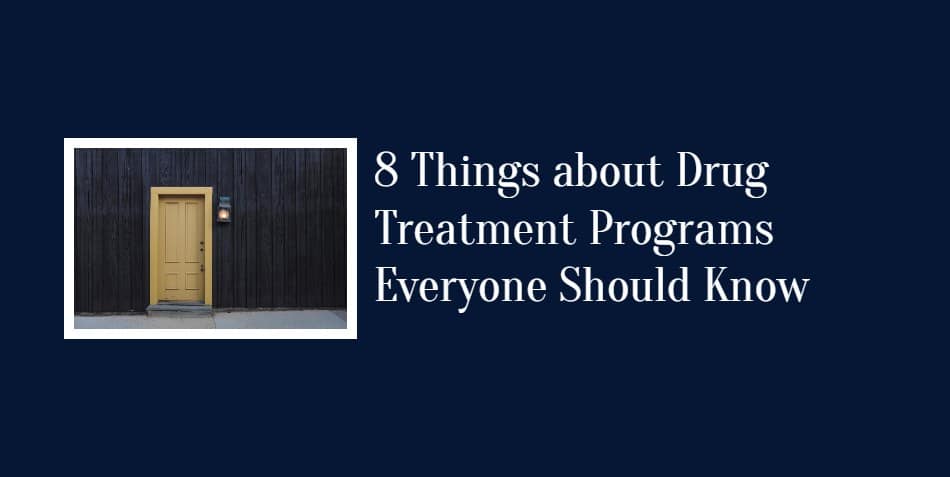The chronic or compulsive use of drugs or alcohol cost US$740billion in health care, criminal activity, and lost productivity. This is why medical professionals use Drug Treatment Programs and Substance Abuse treatments to help wean away individuals from compulsive drug seeking and use behavior.
According to the Substance Abuse and Mental Health Services Administration (SAMHSA), 19.4%, or nearly 1 out of 5 people in the United States used an illicit drug in 2018. Of this figure, 8.1 million had an illicit drug use disorder. See RehabAid’s accurate and useful state-by-state interactive drug overdose map for real time overdose rates in the US.
What is a drug treatment program?
Drug treatment programs (rehabs) combine the types, components, dimensions, elements, approaches, techniques, therapies, and modalities of treatment and other services based on the severity of an individual’s drug addiction and his/her needs and situation. Substance use disorder, including illicit drugs, can be mild, moderate, or severe.
There are various drug treatment programs available for people with substance use disorder. What should you know about these programs? Below are eight things to consider.
1. 24/7 substance abuse treatment helpline
Information on drug or alcohol disorder treatment is always available. The Substance Abuse and Mental Health Services Administration (SAMHSA) has a round-the-clock free and confidential helpline available nationwide for treatment referral and information service. The helpline received 833,598 calls in 2020.
2. Locating treatment facilities near you
SAMHSA helps you locate a treatment center near you. Check out the site, type your city or zip code in the treatment services locator. Once you click search, the site will display a menu of the nearest treatment facilities. Additionally, the site offers additional information on addiction treatment options, cost of treatment, and modes of payment.
3. Goals of addiction treatment programs
The primary goal of substance abuse treatment (health treatment) is for an individual to abstain from taking illicit drugs. Becoming drug-free is only the beginning. Additionally, various types of treatment programs also address problems related to drug abuse. These are medical conditions, mental illness, strained relationships with loved ones, inadequate social and life skills and functioning, poor performance at work or in school, etc. In addition to abstaining from drug use, a treatment program goal is to improve various dimensions of life functioning and relapse prevention.
4. No one size fits all drug addiction treatment program
A person seeking treatment for his addiction has a unique set of life circumstances that played a role in his drug or alcohol misuse. However, the type of treatment program will depend on his particular case. Doctors can customize drug treatment programs based on the severity of the disorder, circle of support, and other medical or mental conditions. Additionally, doctors may also consider a person’s life skills and economic or insurance status. An individual’s active involvement in his treatment process increases its effectiveness.
5. Inpatient or outpatient treatment
Substance abuse treatment that is done in-residence in a hospital or clinic setting for a set period is referred to as inpatient treatment. Inpatient rehab provides residential care to individuals supervised by medical professionals. This allows for a more intensive treatment.
On the other hand, outpatient treatment programs allow individuals to live outside a residential treatment facility while availing themselves of treatment and services. These include staying in sober living facilities. These are usually for individuals with a strong network of social support and who can continue with their life functioning despite their addiction.
6. Short-term or long-term (addiction) substance abuse treatments
Treatment that lasts for up to 30 days is considered short-term. Individuals in short-term residential treatments that are intensive usually need a follow-up outpatient treatment program or aftercare program to minimize relapse.
On the other hand, long-term treatments are those that last for three months to a year. It can be a combination of inpatient and outpatient rehab for individuals requiring specialized programs for their addiction.
7. Individual or group therapy
Individual therapy addresses other issues related to drug abuse through behavioral therapy. The objective is to help the person enhance their life skills and tools, and coping strategies to stop drugs or alcohol.
On the other hand, therapeutic communities use group counseling to provide the peer support needed to change behaviors and lifestyles. Along with individual therapy, group therapy that utilizes the principles of cognitive behavioral therapy results in positive outcomes for the individual.
8. Drug Treatment programs work
Studies have shown that substance abuse treatment programs work. Majority of chemically dependent individuals who undergo a treatment program reach a point where they stop using drugs. There is a also evidence of decreased frequency and severity of relapse for individuals seeking treatment for their substance use disorder.
Conclusion for Substance Abuse Treatment
Going through the list is an excellent way to know more about drug treatment programs. This can help you, your family, loved ones, or someone you know who may be struggling with chemical dependency. Acknowledging and taking action to treat substance use disorder is usually the first step on the road to recovery.
You may want to check out the Ovus Medical blog news section to know more about drug abuse, testing, and treatment programs.
